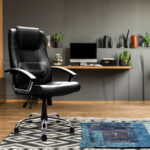This post contains affiliate links, and we will be compensated if you buy after clicking on our links.
Millions of people suffer from herniated discs, a condition that can cause pain, numbness, and weakness in the back, neck, and other areas.
If you are one of those people, you may be wondering how to best sit with a herniated disc. In this blog post, we will give you some tips on how to sit with a herniated disc so that you can minimize your pain and discomfort.

What is herniated disc and what are the symptoms?
According to the Mayo Clinic, a herniated disc is “a condition that occurs when a disc in your spine ruptures or bursts and leaks.”
This can happen due to a variety of reasons such as age, injury, or overuse. When a disc herniates, it can put pressure on the spinal cord or nerves which can lead to pain, numbness, and weakness.
In a simple way, a herniated disc is when the jelly-like center of your spinal disc pushes out through a tear in the tougher outer layer. This can cause pain because it irritates or puts pressure on nerves.

How to Sit With Herniated Disc
If you have a herniated disc, it is important to find a position that is comfortable for you and that minimizes your pain. Here are some tips on how to sit with a herniated disc:
- Sit in a chair that has good back support. If your chair does not have good back support, you can use a pillow to support your lower back.
- Sit up straight and avoid slouching. Slouching can put additional pressure on the discs in your spine.
- Avoid sitting for long periods of time. If you must sit for long periods of time, take breaks often to move around and stretch.
- When getting up from a seated position, do not twist or bend your back. Instead, stand up straight and then pivot your feet to turn your body.

What to avoid when sitting with a herniated disc
There are also some things that you should avoid doing when sitting with a herniated disc. These include:
- Avoid crossing your legs. This can put additional pressure on the discs in your spine.
- Avoid sitting on soft surfaces such as sofas or chairs without back support.
- Do not sit in the same position for long periods of time.

What are some other ways to reduce pain from a herniated disc?
In addition to following the tips above, there are some other things you can do to reduce pain from a herniated disc. These include:
- Applying ice or heat to the affected area.
- Taking over-the-counter pain relievers such as ibuprofen or acetaminophen.
- Engaging in low-impact activities such as walking or swimming.
- Doing exercises that are specifically designed to strengthen the core muscles.
- Undergoing physical therapy.

5 Exercises for a Herniated Disc
If you are looking for specific exercises to help relieve pain from a herniated disc, here are five that may help:
- Pelvic tilts: This exercise helps to strengthen the abdominal and back muscles.
- Bridge: This exercise helps to strengthen the back and buttocks muscles.
- Clamshells: This exercise helps to strengthen the abdominal, hip, and buttocks muscles.
- Bird dog: This exercise helps to strengthen the back and leg muscles.
- Superman: This exercise helps to strengthen the back muscles.
When should you see a doctor about your herniated disc symptoms?
If you are experiencing severe pain, numbness, or weakness from a herniated disc, it is important to see a doctor.
They will be able to properly diagnose your condition and recommend the best course of treatment. Treatment for a herniated disc may include physical therapy, exercises, injections, or surgery.
In rare cases, a herniated disc can lead to paralysis, so it is important to seek medical attention if you are experiencing any of these symptoms.

Conclusion
Sitting with a herniated disc does not have to be painful. By following the tips above and avoiding certain activities, you can help to minimize your pain and discomfort.
If you are still experiencing severe symptoms, it is important to see a doctor so they can properly diagnose and treat your condition.
FAQ
Q. Will my herniated disc go away on its own?
A. In some cases, a herniated disc may heal on its own. However, if you are still experiencing pain after a few weeks, it is important to see a doctor so they can properly diagnose and treat your condition.
Q. Can I exercise with a herniated disc?
A. Yes, in most cases you can still exercise with a herniated disc. However, it is important to avoid high-impact activities and instead focus on low-impact exercises such as walking or swimming. You should also avoid any exercises that put additional strain on the discs in your spine.
Q. What is the best position to sleep in with a herniated disc?
A. The best position to sleep in with a herniated disc is on your side with a pillow between your knees. This will help to take pressure off of the discs in your spine. You may also want to consider sleeping on an adjustable bed so you can adjust the position of your head and legs.
Q. Can I sit in a recliner with a herniated disc?
A. Yes, you can sit in a recliner with a herniated disc. However, it is important to avoid sitting for long periods of time without moving around. You should also avoid crossing your legs or sitting on soft surfaces such as sofas or chairs without back support.
Sources
- Mayo Clinic: “Herniated Disk: Symptoms and Causes”
- WebMD: “Herniated Disk? Exercises for Relief”
- SpineUniverse: “Can I Exercise with a Herniated Disc?”
- Healthline: “Sleeping with a Herniated Disc”
Related Articles:
- The Best Exercises for a Herniated Disc
- Best Chairs for a Herniated Disc
- How to Sit with a Herniated Disc
- How to choose a chair for a herniated disc









